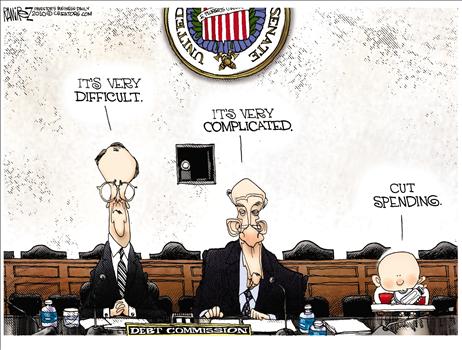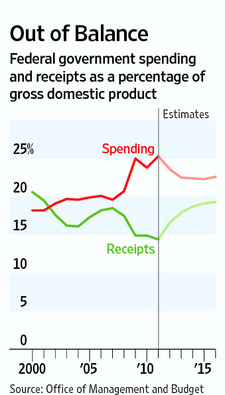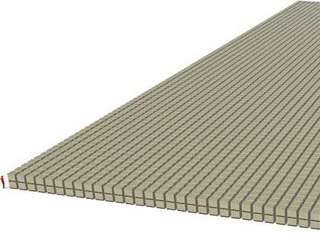|
Spending Reform
Contents Select from the right to skip to the sections that interest you. |
|
Introduction and Scope Definition
Have you asked your children how THEY intend to pay for the government spending, benefits, and programs WE demand that they provide to us TODAY?
When do you intend to demand that THEY figure out how to pay up for US?
The fact is that huge BORROWING means that huge REPAYMENT will be required from others (including those we say we love.) A strategy of borrowing means we are requiring THE FUTURE to pay for the things we want delivered and guaranteed NOW.
That may be fine for a house or a car, the things we call "one-time" purchases. So long as we reduce our spending on other things in order to pay the debt for them off. It doesn't work out so well if we do that for "regularly occurring" purchases. The things we know we will be buying every day or every week. For those, we must "live within our means." No one escapes the consequences of this math over the long term.
Requiring those in the future to pay for expenses we are choosing to incur today, especially without that generation's permission, is called, fairly, "generational theft."
Once we admit this generational theft to ourselves, fixing it by living within our means, and backing away from this fraud is actually rather simple.
Who knew actual facts could be so interesting? If you read no further, check out the four simple, and unspun truths about our federal deficit spending below...
In 2010, fed revenue was $2.2 trillion. In 2003, spending was $2.2 trillion. If we spent as much in 2010 or 2011 as we spent in 2003 (after the Iraq War began) we'd have a balanced budget !
In 2011, the fed government may spend $3.8 trillion. In 2007, spending was $2.7 trillion. Would it really be so difficult for our government to cut its spending by a trillion dollars, and return to the profligate spending binge of 2007 ?
In 2007, fed revenues were $2.6 trillion, spending was $2.7 trillion. Estimated revenues shrunk to $2.2 trillion for 2011, but spending grew to $3.8 trillion. Combined, this sustained growth in spending at the same time that revenues have declined accounts for $1.5 trillion of the anticipated $1.6 trillion annual spending deficit.
If we hit our debt ceiling, our government WILL NOT SHUT DOWN. However, we would have to decrease our spending to 2003 levels. A reduced $2.2 trillion spending budget is a far cry from a shutdown !
Fiscal
YearReceipts
(billions)Outlays
(billions)2001 1,991 1,863 2002 1,853 2,011 2003 1,782 2,160 2004 1,880 2,293 2005 2,154 2,472 2006 2,407 2,655 2007 2,568 2,729 2008 2,524 2,983 2009 2,105 3,518 2010 2,163 3,456 2011est 2,174 3,819 Source:
OMB Historical Tables
The topic of spending, and spending reform is a highly complex one in our nation. It is systemic in scope, and cannot be addressed simply by advocating "controlling our spending, and staying within our means" or "stop robbing our children and our grandchildren" or "we need to cut across the board, and while we are at it, cut whole departments."
The scope of the topic includes:
- Perspective - What's the buzz?
- What's important - the Deficit, the Spending, the Taxes ...?
- The High Level Problem
- The Solution - Duh!
- Why addressing profligate spending matters?
- Click for expanded content
Goals
Sustained overspending and over-commitments with regard to programs, benefits and debt is corrosive to the economic foundation of this nation, its communities, and the social cohesion that holds us peacefully, cooperatively, and productively together.
The primary goal for this Spending Reform section is to provide evidence and a platform for significant, concrete, and sustained reductions in real annual spending on the part of municipal, state, and federal governments.
Spending and revenue balance are instrumental in nurturing a free nation, able to maintain its own sovereignty. It creates a long term environment supporting innovation and improved standards of living for all citizens.
Considering the Big Picture
- Our federal government has grown its spending dramatically over the last several years.
- As the overspending now amounts to trillions of dollars a year, clearly the deficit problem is not related to lack of revenue.
- The federal government's spending and debt predicament is like a friend who earns $1000 per month, and borrows an additional $760 per month from you and other friends until he now owes $78,900. Actually, it's worse.
Click for expanded content
Selected Resources
- Our Spending Reform related videos
- Debt information resources
- Click here to find out what federal government spending is actually costing YOU
- Congressional Budget Office's (CBO's) Monthly Budget Review for Feb 2011.
A deficit that is still at 1.5T annually, and with a House now under new, ostensibly fiscally conservative control, is a result that falls quite a bit short of the mark of the voters who sent our new representatives there!
Spending reduction proposals have been made, and none implemented:

- President's commission
- Rand Paul's proposals
- Paul Ryan's proposals
- Rep. Paul Ryan's daring budget proposal, The Washington Post, 01 Feb 2011
- The Path to Prosperity, 05 April 2011
- GAO's identified areas of waste and duplication
- Congressional Budget Office (CBO) proposals:
A Proposed Comprehensive Solution for
Bringing Spending in Line with Revenues
We propose here that the federal government, and those state governments that are in trouble, make across the board spending reductions to their budgets. While this appears to imply a degree of thoughtlessness, or non-strategic thinking, the proposal IS being made for very strategic reasons.
In addition, we assert that budget reform proposals that take longer than two to three years to meet their goals are not credible. For example, if the goal is to "balance budget spending with incoming revenues so that fiscal deficits are eliminated", than a plan to deliver that result in two years or less has the greatest chance to meet its goal. Why? Budget agreements basically last as long as the next year's budget planning process. Especially when politics are in play.
Plans that tout end-goals 8 to 10 to 12 years out ... essentially show no stomach for hard decisions, and push those off to later legislatures and administrations which, of course, will want to push those out further.
This proposal stubs out a process for balancing the federal budget in two years, with a third for clean-up.
Click for expanded content
- Set the Baseline from which Total Spending will not grow
- Assess the deficit, and cut it by half the first year
- Make the cuts across the board, by even percentages. Incorporate any funding swaps and drops that can be quickly agreed to that keeps the overall spending cut constant.
- In the second year, cut the last half of the spending that represents a deficit vs. the authorized Baseline budget spending.
- By 3rd Year, we have only a few decisions to make.
- Click for expanded content
Our Position
- In a situation where overall government overspending must be cut, so that spending matches the taxes and fees it takes in, then those who advocate projects and spending that MUST NOT BE CUT are part of the problem. Thus, we are all part of the problem. This is, ultimately, economically corrosive
Click for expanded content
- When we don't "pay it back", someone gets hurt. There is less to lend again to another, and those who have lent have lost what they have trusted us with.
- Consider this - when you are approached by your favorite charity, do you take out a loan to contribute to it? Do you take out a loan that your children are obligated to pay? That your neighbor or your neighbor's children are obligated to pay?
This is what we do when we insist that governments borrow to meet today's expenses that are in excess of the taxes and fees they collect today.
- It is necessary to come together as communities in order to provide for a FEW of our common needs - roads, protection, parks, etc. The majority of our needs, however, common or not, we must take care of on our own. Thus, it is reasonable that ALL contribute a share of what they have in supporting a common infrastructure that helps our communities to prosper.
When the scope of the foundation being provided becomes too large, however, the effect becomes corrosive to a community, a state, a nation. Overall prosperity erodes. Social cohesion suffers.
- When we stop raising the debt limits, and stop creating and promising future obligations that we have not set aside savings for, then we will know what it is like for governments to live within their (our) means.
Frequently Asked Questions
Isn't spending less on the poor racist? Anti-immigrant? Discriminatory?Answer
What right do we have to reduce the benefits we have promised to others, that they have expected to depend upon?Answer
Can't we just tax the rich?Answer
How has this happened to us?Answer
We've done fine so far. Every generation has its challenges to overcome. Why can't we just continue with what we are doing and figure this out somehow?Answer
But don't we need a strong military, a good transportation infrastructure, better education, world class research in health care and technology, safety nets for the poor, fire and police protection, inspectors to insure food and product safety, parks and recreation, and benefit programs for those who have served us? And, any other meritorious program that went unmentioned?Answer
Summary
|
Our current fiscal deficit and debt situations seem intractable to many. Too large. Too incomprehensible. Too complex. Too difficult.
They are not. What appears to be difficult is the making of a decision to spend less. There is no reason, inherently, why this decision need be difficult at all, other than that we simply do not want to make it. After all, if we keep spending and growing our debt at our current rate, who are we hurting? Consider all those who believe they are dependent on that spending for their favorite program or need - don't they get hurt when spending is cut? Well, if the economy collapses, who gets hurt? Think it can't happen? What makes us so different from every other country whose economy has collapsed under the weight of too much debt, too much spending, too many obligations that are easier to promise than they are to deliver, and, eventually, too much money printing when there are no other sources to loan us money in order to support our rate of over-spending? Name one country in the history of human-kind's recorded history that has ever been able to sustain growing its debts ever higher than it has the ability to repay? There are none. And, while we have been, and have the possibility of continuing to be an exceptional nation, we will not be the nation that becomes the first nation on the planet ever to borrow and spend its way out of its crushing debt and social obligation burdens. We will have to exercise wisdom. We will have to draw upon courage. We will have to embrace our own abilities to weather austerity now for the sake of a much brighter future of opportunities for those coming after us. We can adapt to whatever is thrown at us, and we will survive. Our choice is simple. Do we want to adapt to a future that we have a hand in crafting, that preserves options? Or, do we want to adapt to a future where forces we cannot control dictate options for us ... after an economic collapse born of cowardice, envy, and greed? Fiscal conservatives will chose the ability to determine their own futures every time! Let's cut the program spending, and get things down to their necessary roots. Let's understand where we have been duped by ourselves and our politicians, and move on. It is not the job of those who come after us to cover mistakes we have made born of poor judgement or neglect. Rather, it our responsibility to make a positive impact on our nation and its future by agreeing to reduce our demands on government today so that more is left on the table when it is needed tomorrow. Let's step up! Oh YES, WE CAN!! |




|
Last Update: Nov 23, 2011 18:45 PDT
